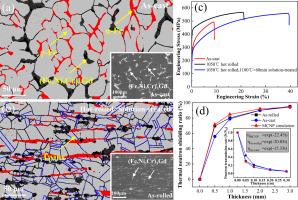用于乏核燃料储存和运输的富钆 316 L 奥氏体不锈钢中子屏蔽材料的热变形行为和热轧性能
IF 4.8
2区 材料科学
Q1 MATERIALS SCIENCE, CHARACTERIZATION & TESTING
引用次数: 0
摘要
富钆奥氏体不锈钢作为一种低成本的中子屏蔽结构功能集成材料,被认为是最有希望取代硼中子屏蔽材料的材料。然而,铸态富钆奥氏体不锈钢中子屏蔽材料受高硬度、低熔点、网状、脆性金属间化合物(Fe,Ni,Cr)3Gd 的影响,热加工性能和力学性能很差。本文揭示了富含 Gd 的 316 L 奥氏体不锈钢中子屏蔽材料的热变形行为,建立并验证了构成方程和热加工图。在此基础上,研究了热轧对材料显微组织和性能的影响,主要讨论了轧制温度和后续固溶处理对显微组织、再结晶、力学性能和中子屏蔽性能的影响。研究表明,富钆 316 L 奥氏体不锈钢中子屏蔽材料在变形温度为 950 ∼ 1050 °C 和应变速率为 0.01 ∼ 0.1 s-1 时具有良好的热加工性能。与热轧前相比,1050 °C 热轧 316 L-2.5wt%Gd 中子屏蔽材料的强度、伸长率和中子屏蔽性能分别提高了 1.79 倍、1.96 倍和 1.31 倍。在 1100 °C × 60 分钟固溶处理后,伸长率进一步增加到 39.53 %,是热轧前的 4.32 倍。这项研究为高钆含量奥氏体不锈钢中子屏蔽材料的热机械加工以及提高强度和塑性提供了有价值的见解。本文章由计算机程序翻译,如有差异,请以英文原文为准。

Hot deformation behavior and hot rolled properties of Gd-rich 316 L austenitic stainless steel neutron shielding material for spent nuclear fuel storage and transportation
Gd-rich austenitic stainless steel as a low-cost neutron shielding structural-functional integrated material is considered the most promising material to replace boron neutron shielding materials. However, as-cast Gd-rich austenitic stainless steel neutron shielding materials are affected by high hardness, low melting point, net-like, brittle intermetallic compound (Fe,Ni,Cr)3Gd, and its hot workability and mechanical properties are very poor. In this paper, Gd-rich 316 L austenitic stainless steel neutron shielding material hot deformation behavior was revealed, and the constitutive equation and hot processing maps were established and verified. On this basis, the effects of hot rolling on material microstructure and properties were studied, mainly discussing the effects of rolling temperature and subsequent solution treatment on the microstructure, recrystallization, mechanical properties, and neutron shielding properties. Studies have shown that Gd-rich 316 L austenitic stainless steel neutron shielding material has good hot workability at deformation temperatures of 950 ∼ 1050 °C and strain rates of 0.01 ∼ 0.1 s−1. Compared with before hot rolling, the strength, elongation and neutron shielding properties of 1050 °C hot-rolled 316 L-2.5wt%Gd neutron shielding material are increased by 1.79 times, 1.96 times and 1.31 times, respectively. After solution treatment at 1100 °C × 60 min, the elongation further increased to 39.53 %, which was 4.32 times than before hot rolling. This study provides valuable insights for high Gd content austenitic stainless steel neutron shielding materials thermo-mechanical processing and improving the strength and plasticity.
求助全文
通过发布文献求助,成功后即可免费获取论文全文。
去求助
来源期刊

Materials Characterization
工程技术-材料科学:表征与测试
CiteScore
7.60
自引率
8.50%
发文量
746
审稿时长
36 days
期刊介绍:
Materials Characterization features original articles and state-of-the-art reviews on theoretical and practical aspects of the structure and behaviour of materials.
The Journal focuses on all characterization techniques, including all forms of microscopy (light, electron, acoustic, etc.,) and analysis (especially microanalysis and surface analytical techniques). Developments in both this wide range of techniques and their application to the quantification of the microstructure of materials are essential facets of the Journal.
The Journal provides the Materials Scientist/Engineer with up-to-date information on many types of materials with an underlying theme of explaining the behavior of materials using novel approaches. Materials covered by the journal include:
Metals & Alloys
Ceramics
Nanomaterials
Biomedical materials
Optical materials
Composites
Natural Materials.
 求助内容:
求助内容: 应助结果提醒方式:
应助结果提醒方式:


